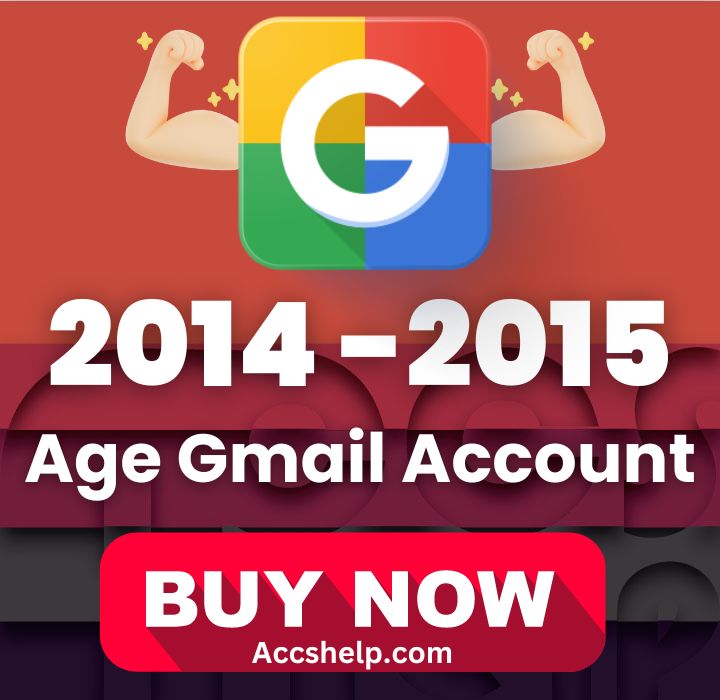This product replacement time is 24 hours.
Password-protected Guarantee.
Fresh Account and Recovery Email Added.
My team offers 24×7 Customer Support.
Money-back guarantees if you don’t like my work.
As much as you like order, There is no problem.
Email: [email protected]
TG: @AccsHelp
skype: AccsHelp or [email protected]
$2.30 $1.80
Between 2014 and 2015, Age Gmail accounts underwent many changes. Google made a lot of updates and improvements that made the user experience completely different. Today, we will look at the specific changes during this period. We’ll discuss the most important feature improvements and how they affect users.

When Gmail first came out in 2004, it quickly became popular because it had new features and was easy to use. Of course, between 2014 and 2015, Gmail changed with updates that improved it and set new standards for email services.
One of the most noticeable changes during this period was the complete redesign of the Gmail user interface. Google introduced its Material Design principles to Gmail, giving the platform a modern and visually appealing look. The new interface featured cleaner lines, bold colors, and a more intuitive layout, enhancing the user experience.
The Material Design update not only made Gmail look better, but it also made it easier to use and more accessible. Gmail’s responsive design made it easy to work on various devices and screen sizes, so users on desktops, tablets, and smartphones all had the same experience.
In 2014, Gmail’s tabbed inbox feature greatly improved how it is organized. Users could easily organize and prioritize their messages with this feature’s automatic sorting of new emails into tabs for primary, social, promotions, and updates.
For a more personalized inbox organization experience, users could change these tabs to suit their needs. This update made it easier to manage emails and focus on important messages by clearing out useless messages from users’ inboxes.
The ability to search in Age Gmail accounts got a big boost between 2014 and 2015, making it easier for users to find specific emails and information. When advanced search filters and operators were added, users could narrow their searches by sender, date, keywords, and attachments, among other things.
Gmail also improved how emails are sorted, so users can now organize their inboxes by date, importance, and size, among other things. These changes made it easier for users to find emails and put them in order of importance, which saved them time and made them more productive.
In 2015, Gmail became fully compatible with Google’s suite of productivity tools, showing that the company was still dedicated to getting things done and working together. Users could open Google Docs, Sheets, and Slides right from their Gmail, which made editing and working together on documents easier in real-time.
Because it works with Google Apps, users can attach files from Google Drive directly to their emails. This made it easier to share documents and helped teams work together. This feature was a big part of making Gmail users’ workflows more efficient and productive.
As worries about cybersecurity grew, Gmail made security improvements a top priority from 2014 to 2015. Two-factor authentication added an extra layer of security to user accounts, making it less likely that someone would get in without permission.
Also, Age Gmail accounts improved its encryption methods to ensure user messages were safe from possible threats. Thanks to these security measures, users felt safe and confident that their email correspondence would be kept private and safe,
The changes introduced to Age Gmail accounts during 2014-2015 profoundly impacted both users and the email industry as a whole.
The new user interface, better organization of inboxes, more advanced search features, seamless integration with Google Apps, and focus on security all improved the experience of using the app. It became easier for users to find important emails, move around in their inbox, work together on documents, and securely talk to each other.
Gmail’s new features set a new standard for email services across the board during this time. As competing services saw how useful features like advanced search, built-in productivity tools, and better security measures were, they started adding them to many different platforms.
From 2014 to 2015, improvements were made to Gmail accounts that set the stage for future improvements to the email service. Since then, updates and new features have built on the improvements made during this time, ensuring that Gmail stays at the top of email technology.
The changes to age Gmail accounts between 2014 and 2015 were very important in the history of email services. New features like a redesigned user interface, better inbox organization, advanced search tools, seamless integration with Google Apps, and stronger security measures changed the way people used their emails in a big way.
These changes not only made the experience better for users, but they also changed industry trends and set new standards for email service providers around the world. Users can look forward to more improvements to Gmail as it grows and changes. These changes will shape the future of digital communication.
| 2015-2018 Year Age Accounts | Buy LinkedIn connect 100+ Accounts |
|---|
Copyright © 2020 AccsHelp.com